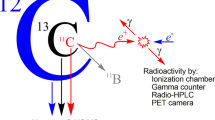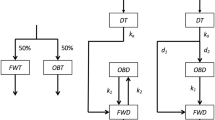Abstract
IT has been suggested1 that complexity of the rose bengal plasma decay curve might be due to the uptake, by organs other than the liver, of different components of the dye. Biörck et al. 2 and Meurman3, using commercial rose bengal labelled with iodine-131, obtained results which made this assumption improbable and have interpreted the plasma decay curve by assuming the existence of a reverse flow of dye from liver cells into the blood.
This is a preview of subscription content, access via your institution
Access options
Subscribe to this journal
Receive 51 print issues and online access
$199.00 per year
only $3.90 per issue
Buy this article
- Purchase on Springer Link
- Instant access to full article PDF
Prices may be subject to local taxes which are calculated during checkout
Similar content being viewed by others
References
Lima, F. W., and Pieroni, R. R., Nature, 184, 1065 (1959).
Biörck, G., Gardell, S., Carlberger, G., and Meurman, L., Nature, 185, 847 (1960).
Meurman, L., Acta Med. Scand., 167, Supp., 354 (1960).
Ishida, Y., Inagaki, N., Shiota, A., and Watanabe, R., J. Pharm. Soc. Japan, 73, 736 (1953).
Liebster, J., and Andrysek, O., Nature, 184, 913 (1959).
Sapirstein, L. A., and Simpson, A. M., Amer. J. Physiol., 182, 337 (1955).
Renault, H., Jacquier, C., Jammet, H., and Jammet, J., in “Radioisotopes in Scientific Research”, 3, 719 (Pergamon Press, London, 1958).
Glaser, W., Gibbs, W. D., and Andrews, G. A., J. Lab. Clin. Med., 54, 556 (1959).
Rosenthal, S. M., J. Pharmacol., 25, 449 (1925).
Wasserman, K., and Mayerson, H. S., Amer. J. Physiol., 165, 15 (1951).
Abdou, I. A., Reinhardt, W. O., and Tarver, H., J. Biol. Chem., 194, 15 (1952).
Forker, L. L., Chaikoff, I. L., and Reinhardt, W. O., J. Biol. Chem., 197, 625 (1952).
Dewey, W. C., Amer. J. Physiol., 197, 423 (1959).
Krogh, A., Acta Med. Scand., Supp., 90, 9 (1938).
Krebs, J. S., and Brauer, R. W., Amer. J. Physiol., 194, 37 (1958).
Kubin, R. H., Grodsky, G. M., and Carbone, J. V., Proc. Soc. Exp. Biol., N.Y., 104, 650 (1960).
Peterson, E. A., and Sober, H. A., J. Amer. Chem. Soc., 78, 751 (1956).
Cohen, S., S. Afr. J. Med. Sci., 23, 245 (1958).
McFarlane, A. S., Nature, 182, 53 (1958).
Cohen, S., Holloway, R. C., Matthews, C., and McFarlane, A. S., Biochem. J., 62, 143 (1956).
Deichmiller, M. P., and Dixon, F. J., J. Gen. Physiol., 43, 1047 (1960).
Author information
Authors and Affiliations
Rights and permissions
About this article
Cite this article
BOCCI, V. Distribution and Fate of Rose Bengal. Nature 189, 584–585 (1961). https://doi.org/10.1038/189584a0
Issue Date:
DOI: https://doi.org/10.1038/189584a0
This article is cited by
-
Läsionale Therapieoptionen beim maligen Melanom
Der Onkologe (2018)
-
The composition of Erythrosins, Fluorescein, Phloxine and Rose Bengal: a study using thin-layer chromatography and solvent extraction
The Histochemical Journal (1976)
-
The uses and limitations of radiosotopes in the investigation of gastrointestinal diseases
The American Journal of Digestive Diseases (1975)
-
The impurities of biological dyes: their detection, removal, occurrence and histological significance?a review
The Histochemical Journal (1969)
-
Metabolism of Rose Bengal
Nature (1962)
Comments
By submitting a comment you agree to abide by our Terms and Community Guidelines. If you find something abusive or that does not comply with our terms or guidelines please flag it as inappropriate.



